Ballistic Kits are essential for personal protection in various situations. Understanding their components, proper usage, and maintenance is crucial for maximizing their effectiveness. This guide dives deep into everything you need to know about ballistic kits, from choosing the right protection level to ensuring long-term durability.
What Constitutes a Ballistic Kit?
Ballistic kits provide varying levels of protection against ballistic threats. They typically include a vest carrier, ballistic panels (hard or soft armor), and often additional accessories like trauma pads and plate carriers. These kits are designed to distribute the impact force of a projectile, reducing the risk of serious injury or death. They are used by law enforcement, military personnel, and increasingly, private citizens seeking enhanced personal safety.
Choosing the Right Ballistic Kit: A Breakdown by Protection Level
Selecting the appropriate ballistic kit depends on the specific threat level anticipated. Different levels offer varying degrees of protection, from handgun rounds to rifle fire. It’s crucial to assess the potential risks and choose a kit that provides adequate protection without sacrificing mobility and comfort.
Level IIA, II, and IIIA: Soft Armor Protection
Soft armor, often constructed from woven fibers like Kevlar, provides protection against handgun rounds. Level IIA is the lowest level, protecting against smaller caliber rounds, while Level IIIA offers the highest soft armor protection, defending against larger handgun rounds and some shotgun slugs. These are lighter and more flexible than hard armor, making them suitable for concealed carry.
Level III and IV: Hard Armor Protection
For rifle protection, hard armor plates made from materials like ceramic or steel are necessary. Level III protects against most common rifle rounds, while Level IV provides the highest level of protection, stopping armor-piercing rounds. These plates are heavier and less flexible than soft armor but offer superior ballistic resistance.
 Ballistic Kit Protection Levels Chart
Ballistic Kit Protection Levels Chart
Key Considerations When Selecting Your Ballistic Kit
Beyond protection levels, several factors influence the choice of a ballistic kit. Comfort, fit, and intended use are paramount. Consider the climate, the duration of wear, and the specific activities you’ll be engaging in while wearing the kit.
Fit and Comfort: Ensuring Optimal Performance
A properly fitted ballistic kit is essential for both comfort and effectiveness. An ill-fitting kit can restrict movement and compromise protection. Ensure the vest sits snugly against the body without hindering mobility. Adjustable straps and various sizes allow for customization and optimal comfort.
Intended Use: Tailoring Your Kit to Your Needs
The intended use of the ballistic kit will dictate its features and design. Law enforcement officers may require different features than private citizens concerned with personal safety. Consider the specific activities and environments you’ll be operating in when choosing a kit.
 Ballistic Kit Fit and Comfort Guide
Ballistic Kit Fit and Comfort Guide
Maintaining Your Ballistic Kit: Extending its Lifespan
Proper maintenance is crucial for preserving the effectiveness of a ballistic kit. Regular inspections for wear and tear, proper cleaning, and appropriate storage are vital for ensuring long-term durability.
Cleaning and Storage Best Practices
Cleaning should be done according to the manufacturer’s instructions, avoiding harsh chemicals that could degrade the ballistic materials. Store the kit in a cool, dry place away from direct sunlight and extreme temperatures to prevent damage.
Recognizing Signs of Wear and Tear
Regularly inspect the vest carrier and ballistic panels for signs of wear and tear, such as fraying, tears, or cracks. Any damage could compromise the kit’s effectiveness and requires immediate attention.
“Regular maintenance is essential for extending the lifespan of a ballistic kit. Ignoring wear and tear can significantly reduce its protective capabilities,” says Alex Thompson, Lead Ballistics Engineer at SecureTech Solutions.
Conclusion: Making an Informed Decision about Your Ballistic Kit
Choosing the right ballistic kit is a crucial decision for personal safety. By understanding the different protection levels, considering individual needs, and prioritizing proper maintenance, you can ensure the effectiveness and longevity of your ballistic kit. Investing in a high-quality ballistic kit is an investment in your safety and peace of mind.
FAQs
- What is the difference between hard and soft armor?
- How do I determine the right protection level for my needs?
- How often should I inspect my ballistic kit?
- Can I wear a ballistic kit under my clothing?
- What is the lifespan of a ballistic kit?
- How do I clean my ballistic kit?
- Where should I store my ballistic kit?
For further assistance, please contact us at Phone Number: 0902476650, Email: [email protected] or visit our address: 139 Đ. Võ Văn Kiệt, Hoà Long, Bà Rịa, Bà Rịa – Vũng Tàu, Việt Nam. We have a 24/7 customer support team.





